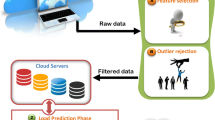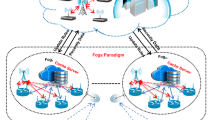Abstract
Smart meters are rapidly installing by utility providers to improve the reliability and performance of Smart Grid. Utility providers analyze real-time smart meter data to monitor, predict, generate and distribute power. The customer’s real-time activity and power usage can be revealed by analyzing the smart meter data. Therefore, the security and privacy of the data is a crucial issue for the smart grid. This paper proposes a secure and privacy-preserving data aggregation and classification (SP-DAC) model based on fog and cloud architecture. Data is aggregated at the fog node in the SP-DAC model, and classification is performed at the outsourced cloud with three machine learning classifiers. Simulation results analyze the cryptographic costs and classification performance. Real-world smart meter dataset “UMass Smart” is taken for experiments and classification accuracy, precision, recall, and F1 score achieved upto 88%, 87%, 90%, and 88%, respectively. The comparison with existing models shows the superiority of the SP-DAC model in terms of features and parameters.










Similar content being viewed by others
References
Badra M, Zeadally S (2017) Lightweight and efficient privacy-preserving data aggregation approach for the smart grid. Ad Hoc Netw 64:32–40
Beckel C, Sadamori L, Santini S (2013) Automatic socio-economic classification of households using electricity consumption data. In: Culler D, Rosenberg C (eds) Proceedings of the fourth international conference on future energy systems. ACM, Berkeley, pp 75–86
Blackout 2003 (2012) http://www.ieso.ca/imoweb/EmergencyPrep/blackout2003 . Accessed 1 June 2021
Boudia ORM, Senouci SM, Feham M (2017) Elliptic curve-based secure multidimensional aggregation for smart grid communications. IEEE Sensors J 17(23):7750–7757
Busom N, Petrlic R, Sebé F, Sorge C, Valls M (2016) Efficient smart metering based on homomorphic encryption. Comput Commun 82:95–101
De Baets L, Develder C, Dhaene T, Deschrijver D (2017) Automated classification of appliances using elliptical fourier descriptors. In: 2017 IEEE international conference on smart grid communications (SmartGridComm), IEEE, pp 153–158
European Commission (2014) Cost–benefit analyses & state of play of smart metering deployment in the EU-27
Framework NIST (2010) Roadmap for smart grid interoperability standards. National Institute of Standards and Technology 26
Geetha R, Ramyadevi K, Balasubramanian M (2021) Prediction of domestic power peak demand and consumption using supervised machine learning with smart meter dataset. Multimed Tools Appl 80(13):5–19693
Gomes P, de Lima ACS, de Pádua Guarini A (2004) Guidelines for power system restoration in the Brazilian system. IEEE Trans Power Syst 19 (2):1159–1164
Jiang L, Luo S, Li J (2012) An approach of household power appliance monitoring based on machine learning. In: 2012 fifth international conference on intelligent computation technology and automation, IEEE, pp 577–580
Kallitsis MG, Michailidis G, Devetsikiotis M (2010) A framework for optimizing measurement-based power distribution under communication network constraints. In: 2010 First IEEE international conference on smart grid communications, IEEE, pp 185–190
Kumari A, Tanwar S, Tyagi S, Kumar N, Obaidat MS, Rodrigues JJPC (2019) Fog computing for smart grid systems in the 5G environment: challenges and solutions. IEEE Wirel Commun 26(3):47–53
Lai LL, Zhang HT, Lai CS, Xu FY, Mishra S (2013) Investigation on July 2012 Indian Blackout. In: Proceeding of the 2013 international conference on machine learning and cybernetics, pp 92–97
Le T-T-H, Kang H, Kim H (2020) Household appliance classification using lower odd-numbered harmonics and the bagging decision tree. IEEE Access 8:55937–55952. https://doi.org/10.1109/ACCESS.2020.2981969
Li D, Dick S (2021) Non-intrusive load monitoring using multi-label classification methods. Electr Eng 103(1):607–619
Li F, Luo B, Liu P (2010) Secure information aggregation for smart grids using homomorphic encryption. In: 2010 first IEEE international conference on smart grid communications, IEEE, pp 327–332
Li F, Luo B, Liu P (2010) Secure information aggregation for smart grids using homomorphic encryption. In: 2010 first IEEE international conference on smart grid communications, IEEE, pp 327–332
Liu H (2020) Appliance Identification Based on Template Matching. In: Non-intrusive Load Monitoring. Springer, Singapore, pp 79–103
Lu R, Liang X, Li X, Lin X, Shen X (2012) EPPA: an efficient and privacy-preserving aggregation scheme for secure smart grid communications. IEEE Trans Parallel Distrib Syst 23(9):1621–1631
Lyu L, Nandakumar K, Rubinstein B, Jin J, Bedo J, Palaniswami M (2018) PPFA: privacy preserving fog-enabled aggregation in smart grid. IEEE Trans Ind Inf 14(8):3733–3744
Merad-Boudia OR, Senouci SM (2020) An efficient and secure multidimensional data aggregation for fog-computing-based smart grid. IEEE Internet Things J 8(8):6143–6153
Mohammadali A, Haghighi MS (2021) A privacy-preserving homomorphic scheme with multiple dimensions and fault tolerance for metering data aggregation in smart grid. IEEE Trans Smart Grid 12(6):5212–5220
Okay FY, Ozdemir S (2016) A fog computing based smart grid model. In: 2016 international symposium on networks, computers and communications (ISNCC), IEEE, pp 1–6
Paillier P (1999) Public-key cryptosystems based on composite degree residuosity classes. In: International conference on the theory and applications of cryptographic techniques. Springer, Berlin
Pradhan A, Sethi K, Bera P (2020) Smart grid data security using practical CP-ABE with obfuscated policy and outsourcing decryption. In: 2020 International conference on cyber situational awareness, data analytics and assessment (CyberSA), IEEE, pp 1–8
Python-paillier A Python 3 library for partially homomorphic encryption using the Paillier crypto system. https://python-paillier.readthedocs.io/en/develop/. Accessed 12 July 2021
Rahman Ab, Hidayah N, Glisson WB, Yang Y, Choo K-KR (2016) Forensic-by-design framework for cyber-physical cloud systems. IEEE Cloud Comput 3(1):50–59
Smart* Data set for sustainability. UMassTraceRepository. http://traces.cs.um-ass.edu/index.php/Smart/Smart/. Accessed 19 June 2021
Sun M, Liu X, Mbonihankuye S (2019) Analysis of the efficiency-energy with regression and classification in household using K-NN. In: International conference on artificial intelligence and security. Springer, Cham, pp 358–368
Tep KS, Martini B, Hunt R, Choo K-KR (2015) A taxonomy of cloud attack consequences and mitigation strategies: The role of access control and privileged access management. In: 2015 IEEE Trustcom/BigDataSE/ISPA, vol. 1, IEEE, pp 1073–1080
Wang Y, Bennani IL, Liu X, Sun M, Zhou Y (2021) Electricity consumer characteristics identification: A federated learning approach. IEEE Trans Smart Grid 12(4):3637–3647
Yan D, Jin Y, Sun H, Dong B, Ye Z, Li Z, Yuan Y (2019) Household appliance recognition through a Bayes classification model. Sustain Cities Soc 46:101393
Zeng Z, Wang X, Liu Y, Chang L (2022) MSDA: multi-subset data aggregation scheme without trusted third party. Front Comput Sci 16 (1):1–7
Zhang Z, Dong M, Zhu L, Guan Z, Chen R, Xu R, Ota K (2017) Achieving privacy-friendly storage and secure statistics for smart meter data on outsourced clouds. IEEE Trans Cloud Comput 7(3):638–649
Acknowledgements
The authors would like to thanks the National Institute of Technology, Kurukshetra, India for financially supporting the research work.
Author information
Authors and Affiliations
Corresponding author
Ethics declarations
Conflict of Interests
The authors declare that they have no conflict of interest.
Additional information
Publisher’s note
Springer Nature remains neutral with regard to jurisdictional claims in published maps and institutional affiliations.
Rights and permissions
Springer Nature or its licensor (e.g. a society or other partner) holds exclusive rights to this article under a publishing agreement with the author(s) or other rightsholder(s); author self-archiving of the accepted manuscript version of this article is solely governed by the terms of such publishing agreement and applicable law.
About this article
Cite this article
Singh, A.K., Kumar, J. A secure and privacy-preserving data aggregation and classification model for smart grid. Multimed Tools Appl 82, 22997–23015 (2023). https://doi.org/10.1007/s11042-023-14599-4
Received:
Revised:
Accepted:
Published:
Issue Date:
DOI: https://doi.org/10.1007/s11042-023-14599-4




